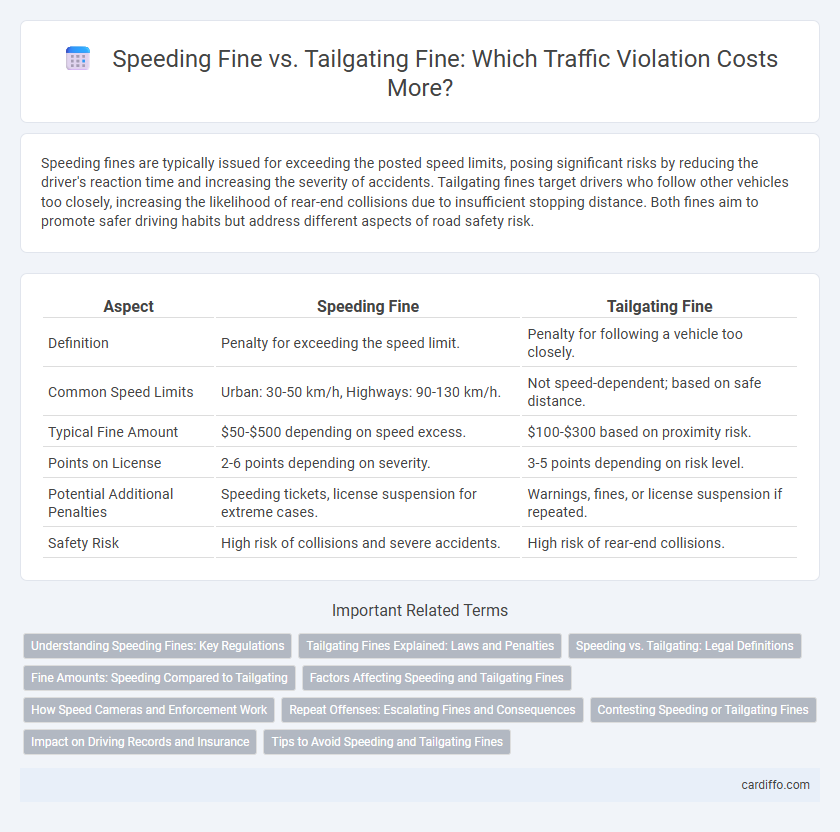Speeding fines are typically issued for exceeding the posted speed limits, posing significant risks by reducing the driver's reaction time and increasing the severity of accidents. Tailgating fines target drivers who follow other vehicles too closely, increasing the likelihood of rear-end collisions due to insufficient stopping distance. Both fines aim to promote safer driving habits but address different aspects of road safety risk.
Table of Comparison
| Aspect | Speeding Fine | Tailgating Fine |
|---|---|---|
| Definition | Penalty for exceeding the speed limit. | Penalty for following a vehicle too closely. |
| Common Speed Limits | Urban: 30-50 km/h, Highways: 90-130 km/h. | Not speed-dependent; based on safe distance. |
| Typical Fine Amount | $50-$500 depending on speed excess. | $100-$300 based on proximity risk. |
| Points on License | 2-6 points depending on severity. | 3-5 points depending on risk level. |
| Potential Additional Penalties | Speeding tickets, license suspension for extreme cases. | Warnings, fines, or license suspension if repeated. |
| Safety Risk | High risk of collisions and severe accidents. | High risk of rear-end collisions. |
Understanding Speeding Fines: Key Regulations
Speeding fines are imposed based on specific speed limits set by traffic authorities, with penalties varying depending on how much the driver exceeds the legal limit. Key regulations often include graduated fines tied to speed ranges, mandatory points on the driver's license, and possible court appearances for excessive speeding. Understanding these rules helps drivers anticipate legal consequences and promotes safer road behavior by deterring high-speed driving.
Tailgating Fines Explained: Laws and Penalties
Tailgating fines are imposed for maintaining an unsafe following distance, violating traffic laws designed to prevent rear-end collisions. Penalties vary by jurisdiction but typically include monetary fines, points on the driver's license, and potential increase in insurance premiums. Understanding local tailgating laws helps drivers avoid these penalties and enhances road safety by promoting adequate spacing between vehicles.
Speeding vs. Tailgating: Legal Definitions
Speeding is legally defined as operating a vehicle at a velocity exceeding the posted speed limit, resulting in fines based on the extent of the speed violation and jurisdictional statutes. Tailgating, or following another vehicle too closely, breaches safe driving laws by compromising adequate stopping distance and is fined under regulations addressing reckless or unsafe driving behavior. Enforcement agencies distinguish these offenses to address specific risks: speeding increases collision impact severity, while tailgating heightens the likelihood of rear-end accidents.
Fine Amounts: Speeding Compared to Tailgating
Speeding fines typically range from $150 to $1,000 depending on the speed over the limit and jurisdiction, while tailgating fines generally start around $150 and can exceed $500 for repeated offenses. Speeding penalties increase significantly with higher speeds, often doubling or tripling for excessive speed violations. Tailgating fines may also include additional points on the driver's license, impacting insurance rates more severely over time compared to typical speeding fines.
Factors Affecting Speeding and Tailgating Fines
Speeding fines vary based on factors such as the extent of speed over the limit, road type, and presence of construction zones or school areas, while tailgating fines depend on the distance maintained from the vehicle ahead, traffic conditions, and risk level caused by the behavior. Jurisdictions apply higher penalties for repeat offenders and incidents leading to accidents or traffic disruptions. Enforcement measures like radar detection for speeding and video evidence for tailgating impact the accuracy and severity of these fines.
How Speed Cameras and Enforcement Work
Speed cameras use radar or laser technology to detect vehicles exceeding speed limits, capturing photographic evidence used for issuing speeding fines. Enforcement of tailgating fines relies on police observation or specialized cameras that measure the distance between vehicles, identifying drivers who follow too closely. Both speeding and tailgating fines aim to enhance road safety by deterring dangerous driving behaviors through automated monitoring and legal penalties.
Repeat Offenses: Escalating Fines and Consequences
Repeat offenses for speeding fines result in escalating penalties, including increased monetary fines and potential license suspension, reflecting the severity of habitual speeding violations. Tailgating fines also escalate with repeated infractions, often leading to harsher penalties such as points on the driving record, higher insurance premiums, and possible mandatory driver safety courses. Both offenses demonstrate a progressive enforcement approach aimed at deterring dangerous driving behaviors through stricter consequences for repeat offenders.
Contesting Speeding or Tailgating Fines
Contesting a speeding fine typically requires evidence such as calibrated speed measurement or procedural errors during the ticketing process, while challenging a tailgating fine often involves demonstrating safe following distances or disputing the accuracy of observational accounts. Legal arguments for both fines center on proving reasonable doubt regarding the officer's assessment or the reliability of enforcement technology. Understanding local traffic laws and gathering corroborating evidence like dashcam footage can significantly increase the chances of successfully contesting either fine.
Impact on Driving Records and Insurance
Speeding fines often result in multiple points on driving records, leading to increased insurance premiums due to higher risk assessments by insurers. Tailgating fines, while sometimes carrying fewer points, can still significantly impact driving records by signaling aggressive driving behavior, which insurance companies penalize with higher rates. Both violations contribute to a negative driving history, but speeding fines typically have a more direct and substantial effect on insurance costs and license standing.
Tips to Avoid Speeding and Tailgating Fines
Maintaining a safe following distance of at least three seconds and adhering to posted speed limits significantly reduces the risk of tailgating and speeding fines. Utilizing cruise control on highways helps regulate speed consistently, preventing accidental violations. Regularly checking speedometer accuracy and staying alert to traffic flow enhances overall road safety and compliance with traffic laws.
Speeding Fine vs Tailgating Fine Infographic

 cardiffo.com
cardiffo.com